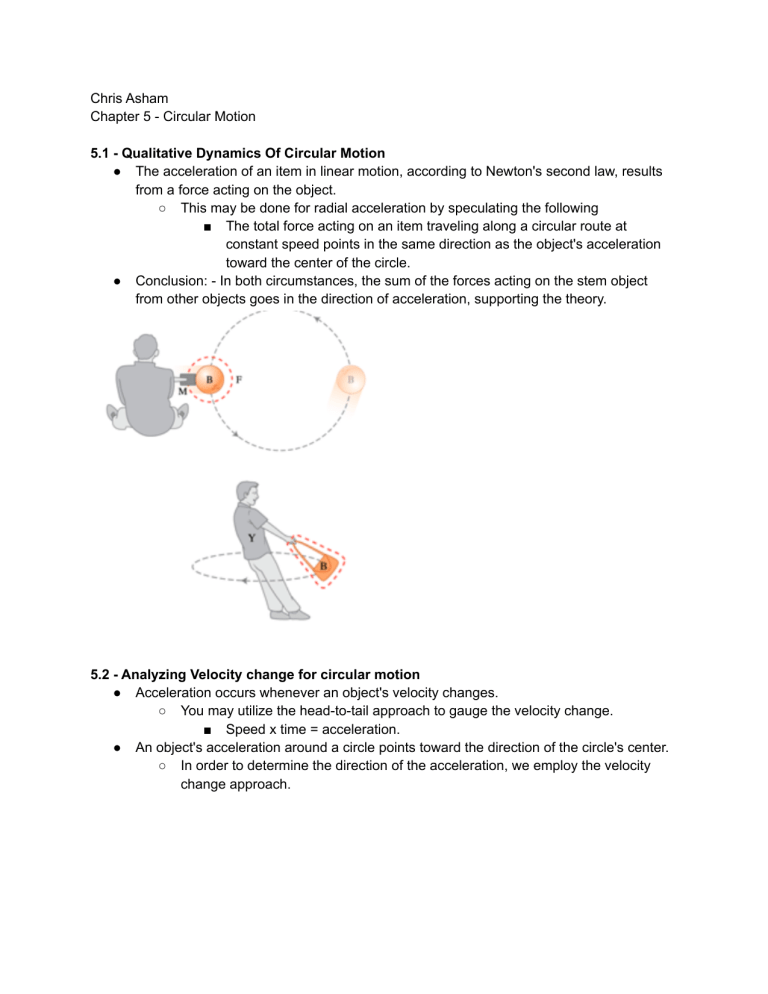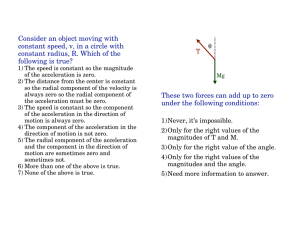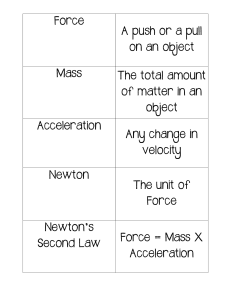
Chris Asham Chapter 5 - Circular Motion 5.1 - Qualitative Dynamics Of Circular Motion ● The acceleration of an item in linear motion, according to Newton's second law, results from a force acting on the object. ○ This may be done for radial acceleration by speculating the following ■ The total force acting on an item traveling along a circular route at constant speed points in the same direction as the object's acceleration toward the center of the circle. ● Conclusion: - In both circumstances, the sum of the forces acting on the stem object from other objects goes in the direction of acceleration, supporting the theory. 5.2 - Analyzing Velocity change for circular motion ● Acceleration occurs whenever an object's velocity changes. ○ You may utilize the head-to-tail approach to gauge the velocity change. ■ Speed x time = acceleration. ● An object's acceleration around a circle points toward the direction of the circle's center. ○ In order to determine the direction of the acceleration, we employ the velocity change approach. 5.3 - Radial Acceleration and Period ● Radial Acceleration: When an item is traveling in a circle at a constant speed, each spot where it experiences acceleration will point in the direction of the circle's center. ● To ascertain the velocity change, two tests were conducted at various velocities. ○ We came to the conclusion that acceleration is inversely related to radius because it reduces by half as the radius doubles for an object moving in a circle at a constant speed. ● Statements about proportionality: ○ Broad Acceleration: ■ The amount of the radial acceleration for an item traveling at constant speed v along a circular route with radius r is ○ The period is the length of time it takes to complete a circle. ■ You may use the period expression in place of the speed expression to determine acceleration in a different approach. 5.4 - Skills for analyzing processes involving circular motion ● Skills for assessing circular motion-based processes: ○ Studying circular motion is quite similar to analyzing linear motion, with the exception that we utilize the radial r-axis and vertical y-axis rather than the conventional x and y axes. ○ Always orient the radial axis towards the direction of the circle's center. Along this axis, the magnitude of the radial acceleration is positive. ● Considering radial direction ○ Approach to Problem Solving: ■ Drawing and Translation: ■ Draw a picture of the issue, annotate the pertinent data, select a framework and a system, and label the unknown. ○ Draw a diagram and simplify: ■ If the system may be represented as a point-like object, draw it as a point. ○ Check to see if the circular motion at constant speed method is acceptable. ○ As the object passes the selected place, show with an arrow the direction of its acceleration. ■ Create a force diagram for the system at that precise moment. ● Draw an axis in the radial direction toward the circle's center on the force diagram. ■ Mathematically express: ■ Put the force diagram into Newton's law's component form. ■ Solve and assess: ● Plug in the values to solve the problem. 5.5 - The Law of Universal Gravitation ● ● ● Planetary motion observations and justifications ○ Gravitational force diminishes with increasing distance. ○ The gravitational force increases with increasing mass. What is the Gravitational Constant? ○ It includes both Kepler's laws and the laws of gravity All planets have elliptical orbits, and the Sun is at one of those foci. ○ Independent of the planet's distance from the Sun, an imaginary line linking it to the planet sweeps the same region continuously over the same period of time as the planet moves through its orbit. ■ the semi-major axis of the orbit divided by the cube of the period T of the planet's motion (the amount of time it takes to complete one orbit)





